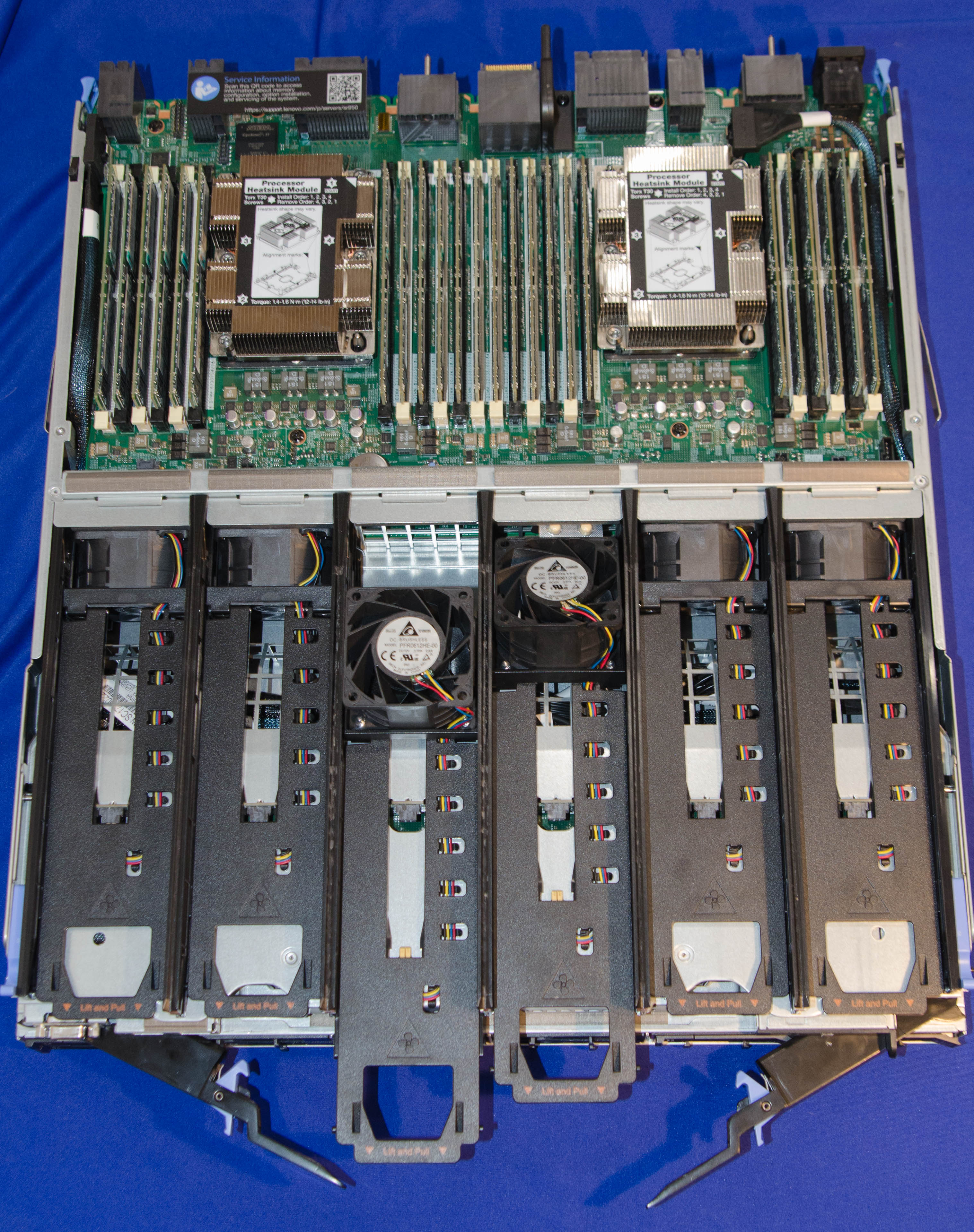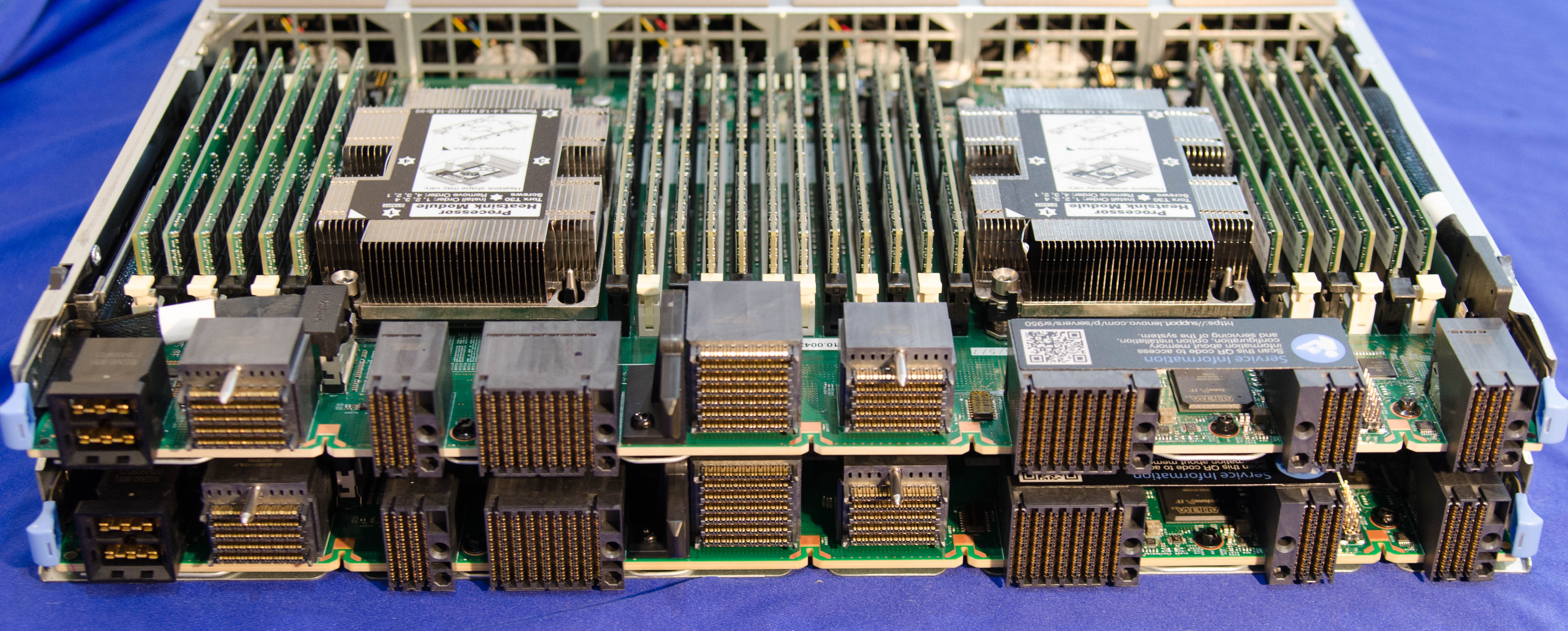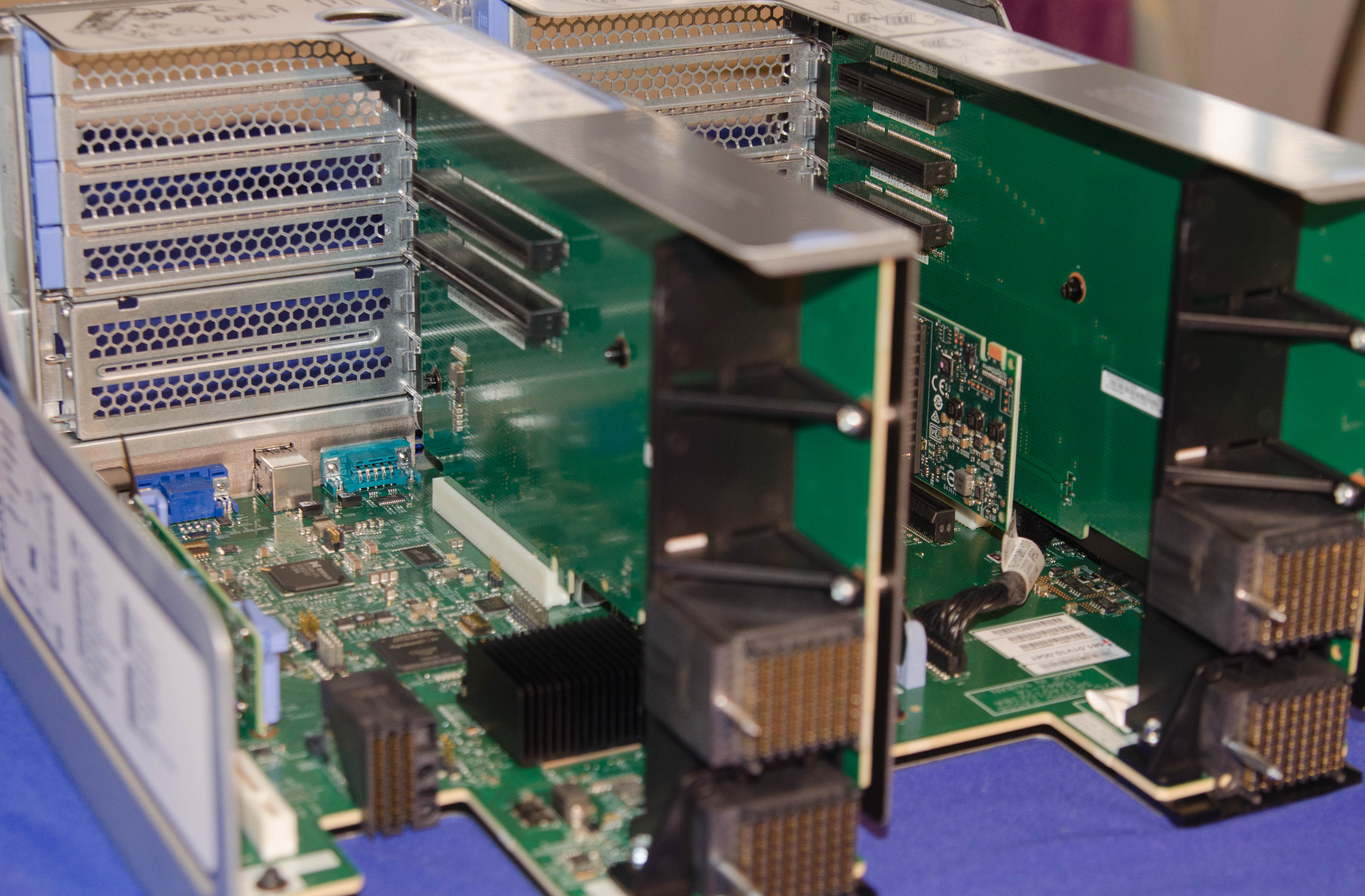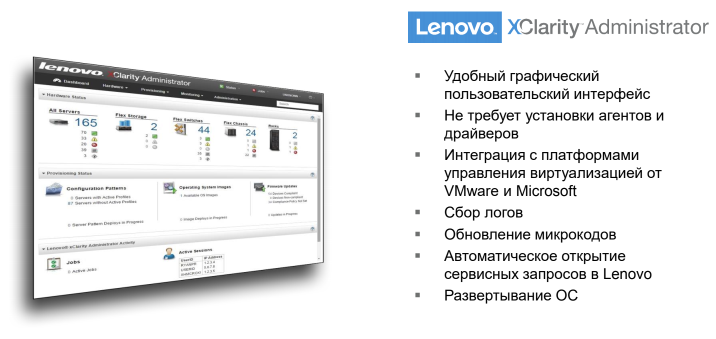Lenovo ThinkSystem SR950 Server Overview
In August this year, Lenovo presented its new line of products for data centers under the ThinkSystem brand , which includes servers, storage systems and switches. If we talk about the server line, then in the framework of the new brand, 14 models of various form factors (floor, rack, high-density and blade servers) were presented, including the top-end ThinkSystem SR950 system, designed to solve critical and resource-intensive tasks such as databases, analytics, ERP, CRM and, of course, virtualization. To get such a system for review at least for a couple of days is a great success and today I will try to tell you about this interesting server in more detail.

The first thing that catches your eye even at the stage of reading technical specifications is the huge possibilities for scaling and expanding the system. From 2 to 8 processors of the new generation Intel Xeon Scalable and the presence of 19 (!) Slots for installing various expansion cards. And all this can be placed in a small 4U case.
When the server came directly into my hands, I was able to make sure that the statements about the modularity of the design had every reason. The front of the server is divided into 2 computing bays, each of which can have up to 4 processors, 48 DIMMs and 12 2.5-inch drives.

Compartments slide forward from the chassis for easy upgrades and maintenance.
The design of the cooling system is made in such a way that replacing a failed cooler takes several seconds and all that is required is to remove the front decorative cover of the server, and then simply pull out the cooler.

The computing module, it is “two-tier”, and coolers are taken out by simple “pulling” from the chassis.

Two “tiers” of one of the computing compartments. each with 2 processors and 48 RAM slots.
It is also worth mentioning that this is not a hyperconverged system consisting of several nodes, all processors operate within a single server.

Interconnect
Perhaps, from the point of view of convenience, I did not like just how the connection of computing modules was implemented. In order to remove the upper tier, you have to disconnect a couple of wires. From this point of view, at one time I liked the solution implemented in the Dell PowerEdge R820 , which I reviewed several years ago. By the way, this is exactly how it is implemented in the younger Lenovo model - ThinkSystem SR850. Perhaps due to the higher density of components, it was difficult to implement such a mechanism here.

Basket for PCIe expansion cards is removable at the back
The growth of computing or storage resources can, of course, be gradual - this flexibility will be convenient for those who know that their resource requirements will increase, but they don’t plan to buy a powerful system at once (for example, considering the linear system, we predict growth of loads). This will allow a more flexible approach to budgeting.
The coordinated work of all hardware components and the use of new Intel Xeon processors allowed the new generation of Lenovo ThinkSystem systems to set 42 world recordsin various computing benchmarks and configurations, ranging from single-processor to 8-processor systems. This suggests a high applicability of new servers to heavy and critical workloads. The key ones in the category “most productive” - I would call:
Speaking directly about the new Lenovo multiprocessor systems, the company is positioning them to solve the most demanding tasks.

Now let's look at the functionality of managing new systems. The updated integrated controller - xClarity Controller (XCC), which replaced IMMv2 - allows you to manage your server settings, provides real-time system monitoring, a KVM console, and information about installed equipment.

The interface is simple, lightweight and works without any complaints. It is also fast enough when compared with competitor systems.

Detailed logging of what is happening in the system

The Inventory tab tells everything about the installed equipment.

Monitoring of components and system utilization in real time

KVM console that does not require Java! HTML5 finally comes to server systems. The

ability to change the configuration of a RAID array directly from the graphics console.

Port status of additional HBA adapters.
In total, the xClarity family of software products includes several components for managing new systems:
In addition, Lenovo provides open access for customers and partners to the xClarity developers forum, where you can offer your own ideas for the development of software products or vote on existing ideas for their early implementation.
Overall, the new Lenovo ThinkSystem server product line left a good impression. In my opinion, new servers should meet two main characteristics - high performance and ease of use. And Lenovo was able to show excellent results in this. I really hope that in the near future I will be able to get acquainted with the younger models of this line and they will also leave a good impression.
I want to thank Lenovo and personally Anton Boldin for the equipment provided for the review.

The first thing that catches your eye even at the stage of reading technical specifications is the huge possibilities for scaling and expanding the system. From 2 to 8 processors of the new generation Intel Xeon Scalable and the presence of 19 (!) Slots for installing various expansion cards. And all this can be placed in a small 4U case.
When the server came directly into my hands, I was able to make sure that the statements about the modularity of the design had every reason. The front of the server is divided into 2 computing bays, each of which can have up to 4 processors, 48 DIMMs and 12 2.5-inch drives.

Compartments slide forward from the chassis for easy upgrades and maintenance.
The design of the cooling system is made in such a way that replacing a failed cooler takes several seconds and all that is required is to remove the front decorative cover of the server, and then simply pull out the cooler.

The computing module, it is “two-tier”, and coolers are taken out by simple “pulling” from the chassis.

Two “tiers” of one of the computing compartments. each with 2 processors and 48 RAM slots.
It is also worth mentioning that this is not a hyperconverged system consisting of several nodes, all processors operate within a single server.

Interconnect
Perhaps, from the point of view of convenience, I did not like just how the connection of computing modules was implemented. In order to remove the upper tier, you have to disconnect a couple of wires. From this point of view, at one time I liked the solution implemented in the Dell PowerEdge R820 , which I reviewed several years ago. By the way, this is exactly how it is implemented in the younger Lenovo model - ThinkSystem SR850. Perhaps due to the higher density of components, it was difficult to implement such a mechanism here.

Basket for PCIe expansion cards is removable at the back
The growth of computing or storage resources can, of course, be gradual - this flexibility will be convenient for those who know that their resource requirements will increase, but they don’t plan to buy a powerful system at once (for example, considering the linear system, we predict growth of loads). This will allow a more flexible approach to budgeting.
The coordinated work of all hardware components and the use of new Intel Xeon processors allowed the new generation of Lenovo ThinkSystem systems to set 42 world recordsin various computing benchmarks and configurations, ranging from single-processor to 8-processor systems. This suggests a high applicability of new servers to heavy and critical workloads. The key ones in the category “most productive” - I would call:
- 2-processor server for OLTP applications: ABS, ERP
- 4-processor server for processing big data and complex transactions
- 2-processor server for virtualized environments
- 1, 2, 4, 8-processor server for Java applications in response time and bandwidth
- 2, 4-processor server for processing and analyzing financial transactions
Speaking directly about the new Lenovo multiprocessor systems, the company is positioning them to solve the most demanding tasks.

Now let's look at the functionality of managing new systems. The updated integrated controller - xClarity Controller (XCC), which replaced IMMv2 - allows you to manage your server settings, provides real-time system monitoring, a KVM console, and information about installed equipment.

The interface is simple, lightweight and works without any complaints. It is also fast enough when compared with competitor systems.

Detailed logging of what is happening in the system

The Inventory tab tells everything about the installed equipment.

Monitoring of components and system utilization in real time

KVM console that does not require Java! HTML5 finally comes to server systems. The

ability to change the configuration of a RAID array directly from the graphics console.

Port status of additional HBA adapters.
In total, the xClarity family of software products includes several components for managing new systems:
- xClarity Controller - built-in physical controller (aka BMC) for remote server management. Its functionality I briefly described above. I add that it supports the RedFish API standard to provide integration with third-party applications and management interfaces.
- xClarity Provisioning Manager is a server configuration and OS deployment tool built into every new ThinkSystem (aka ServerGuide, which had to be installed separately to configure IBM System x servers).

- xClarity Administrator is centralized management software for Lenovo's entire infrastructure that supports the management of both the new ThinkSystem and the previous generation System x M5 and M4. Available and free version .

- xClarity Mobile is a mobile application for Android and iOS for connecting a mobile device to the system.

In addition, Lenovo provides open access for customers and partners to the xClarity developers forum, where you can offer your own ideas for the development of software products or vote on existing ideas for their early implementation.
Overall, the new Lenovo ThinkSystem server product line left a good impression. In my opinion, new servers should meet two main characteristics - high performance and ease of use. And Lenovo was able to show excellent results in this. I really hope that in the near future I will be able to get acquainted with the younger models of this line and they will also leave a good impression.
I want to thank Lenovo and personally Anton Boldin for the equipment provided for the review.
